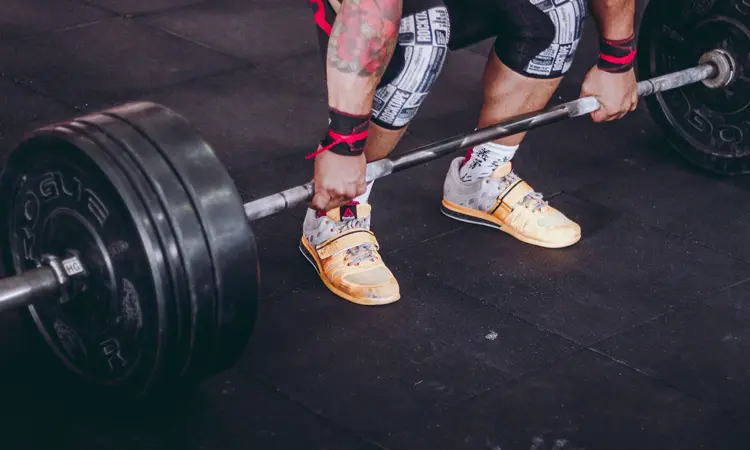For new lifters, the idea of starting a strength training may be daunting. Therefore, to guide you on your way to success, it is recommended that you follow a strength training program.
When it comes to beginner training plans there are many to choose from. This can make it difficult to differentiate the effective from the ineffective.
However, one of the most effective beginner strength training programs is “Starting Strength” by Mark Rippetoe.
This article will provide details on the Starting Strength plan and explain what makes it a great choice for strength training beginners.
What is Starting Strength LP Program
As the name of the program suggests, “Starting Strength” is a barbell-based resistance program aimed at the strength training beginner.
It’s a scientifically based plan that has helped thousands of novice lifters make significant progress in terms of muscular strength and size.
Level Up Your Fitness: Join our 💪 strong community in Fitness Volt Newsletter. Get daily inspiration, expert-backed workouts, nutrition tips, the latest in strength sports, and the support you need to reach your goals. Subscribe for free!

The program itself is clear and simple. It sticks to the essentials of strength training and gradually progresses to ensure that optimal results are achieved.
Starting Strength can be broken down into four phases. The rate at which you move through these phases depends entirely on how quickly you make progress with your strength and movement.
In phase one, the focus is on laying foundations to be built upon. As a result, the emphasis is on learning the exercises and movement patterns.
After you’ve developed proficiency with phase one, you can move on to phase two. This phase adds an explosive element to your training with an exercise known as the power clean.
At phase three, chin-ups are added and the intensity continues to gradually increase to maximize strength development. Out of all of the phases, phase three is likely to last the longest.
Finally, phase four is known as the advanced novice stage. This phase introduces one lighter squatting session along with heavy squats twice per week.
Starting Strength Program Spreadsheet
Download the Starting Strength LP Spreadsheet below:
Starting Strength Linear Periodization
Many popular beginner training programs follow a structure known as linear periodization (or linear progression).
Linear periodization programs gradually increase training intensity while progressively reducing training volume in order to maximize results (1).
The goal with linear periodized programs is to lift a greater amount of weight for each exercise every session.
Programs that follow linear periodization are popular in beginner training programs for a number of reasons.
Linear periodization programs are straightforward and easy to follow. For someone who is new to strength training, intricate programs can be confusing and overly challenging.
The simplicity of the Starting Strength workouts makes this program highly attractive to the novice.
Additionally, those who are new to strength training tend to make rapid progress. This is something that Mark Rippetoe refers to as the “novice effect”.
The novice effect occurs because the training stimulus is something new. Therefore, the body reacts and adapts extremely quickly in order to deal with the stress of training.
As a result, it is not uncommon for a beginner lifter to experience improvements on a session to session basis.
The untrained individual may initially be capable of adding as much as ten pounds to their deadlift and squat, and five pounds to upper body exercises per week.
With linear periodization, the goal is to lift more and more weight over time. Therefore, this is the perfect training structure to maximize the novice effect and make large advancements in strength.
Starting Strength Routine
In addition to the simple program structure, the starting strength routine could not be much more straightforward.
There are only two workouts found in the Starting Strength program – workout A and B. These two workouts are alternated with each session.
The program demands that you train three times each week and uses a one day on, one day off pattern. This allows the body to fully recover between training sessions.
The most common way of scheduling training is to work out on Monday, Wednesday, and Friday and use the other days for recovery.
However, providing that recovery days are incorporated into the schedule, you can use whatever structure works best.
Here is the example routine:
| Week 1 | Week 2 | ||
| Monday | Workout A | Monday | Workout B |
| Tuesday | Rest | Tuesday | Rest |
| Wednesday | Workout B | Wednesday | Workout A |
| Thursday | Rest | Thursday | Rest |
| Friday | Workout A | Friday | Workout B |
| Saturday | Rest | Saturday | Rest |
| Sunday | Rest | Sunday | Rest |
Starting Strength Workouts
Workouts A and B are both full-body workouts that focus on compound exercises. These are exercises that activate numerous muscle groups across a range of joints.
Compound exercises are highly effective for building muscular strength and size (2).
In the first phase, there are only four exercises to be performed – the squat, deadlift, bench press, and overhead press.
These four exercises are commonly seen as the ultimate strength-building exercises. As a result, they tend to be the foundation of the majority of effective strength programs.
Excluding warm-up sets, the squat and overhead press are to be performed for three sets of five repetitions while the deadlift is programmed for just one set of five repetitions.
Level Up Your Fitness: Join our 💪 strong community in Fitness Volt Newsletter. Get daily inspiration, expert-backed workouts, nutrition tips, the latest in strength sports, and the support you need to reach your goals. Subscribe for free!
As you move through phases two and three, two more exercises are added – the power clean and chin-up.
Because the training structure remains the same, adding these exercises into the routine is straightforward.
Upon reaching phase four, you will notice that the workouts have not significantly changed since phase one.
In phase four, squats are still to be performed three times per week, however, now there is one light squat day and two heavy squat days. Other than that, the workouts are very similar.
Starting Strength Training Volume
When it comes to training volume, many believe that five sets of five reps yields the greatest improvements in muscular strength and power.
The conventional understanding is that performing sets of one to five reps is best for strength, six to twelve for hypertrophy, and twelve or more for endurance.

From research conducted on differing loads and rep ranges, it is clear that heavyweight is most optimal for building strength (3).
This explains why the majority of powerlifting and strength-building training programs tend to focus on performing five reps with compound exercises.
Starting Strength is no different and both workouts focus on performing sets of five reps with all exercises.
However, the program does not prescribe five sets per exercise.
For the squat, bench and overhead press, three working sets of five reps are to be performed.
Due to the specific demands of the exercises, the volume differs with the deadlift and power clean.
For the deadlift, only one working set is required whereas, with the power clean, five sets of three reps are to be performed.
There are a number of reasons why the Starting Strength program uses less training volume.
First of all, Starting Strength has not been designed as a powerlifting program. Typical powerlifting programs are founded on five by five.
While the program does indeed have some similarities to powerlifting programs, it has not specifically been created for powerlifters.
Rather, the purpose of Starting Strength is to allow beginners to begin strength training in a safe and most efficient manner.
Considering the fact that this program has been designed for the absolute beginner, performing five sets of five reps will likely be overly demanding and unsustainable.
As highlighted, beginners do not need a large training stimulus in order to make substantial progress in strength and size.
By performing a high volume of training, the beginner will not be able to deal with the demands of training which may cause overtraining.
When overtraining occurs, significant regressions in strength and size, extreme fatigue, and injury may be experienced (4).
Furthermore, to maximize the “novice effect”, the weights used should still be challenging while promoting proper form.
Much of the adaptations seen during the novice effect are neural (5). Consequently, during workouts, there should be a great focus on your movement and form.
Using heavy weights for five sets may lead to significant fatigue build-up and prevent the individual from completing all sets and reps with good form.
Moreover, a compromised form can interfere with development and increase the risk of injury.
Starting Strength Book
For more information on Starting Strength and how it works, refer to Mark Rippetoe’s book titled “Starting Strength: Basic Barbell Training”.
Rippetoe has utilized all the knowledge and experience he has accumulated over the years to write a simple, clear, and effective training guide.
As well as providing the Starting Strength program, the book also provides a full breakdown and an in-depth guide on the compound lifts that are utilized in the program.
Since its release in 2005, the book has sold over 250,000 copies and has helped thousands of people worldwide build incredible strength.
Other Powerlifting Programs
- The Greyskull Linear Periodization Program (GSLP) Good or Bad?
- nSuns 531 LP Powerlifting Program Guide with Spreadsheets
- The Juggernaut Method: Unstoppable Strength Training Program
- Madcow 5×5 Program: The Workout for Strength and Size
- The High Bar vs Low Bar Squat Debate
FAQ’s
Q1) Is Starting Strength a powerlifting program?
A) While it certainly has powerlifting influences, the program has not specifically been designed for powerlifters. Rather, it is for absolute novices looking to start strength training.
Q2) What are the five key Starting Strength exercises?
A) The workouts revolve around five compound exercises; the squat, deadlift, bench press, overhead press, and power clean.
Q3) What is the novice effect?
A) Mark Rippetoe coined the term in reference to the phenomenon where novices experience rapid adaptations in response to strength training.
Q4) When should you move on from the Starting Strength program?
A) There are four distinct phases of Starting Strength. Once you have moved through all four phases should you consider moving onto a more advanced training program.
Final Word
For those who have never used a barbell or performed any form of strength training before, the Starting Strength training program is a great place to start.
Not only is it easy to grasp, but the combination of linear progression, effective exercise selection, and adequate training volume allows the novice to build strength in the most optimal fashion.
References:
1 – Lorenz, Daniel S.; Reiman, Michael P.; Walker, John C. (2010-11). “Periodization”. Sports Health. 2 (6): 509–518. doi:10.1177/1941738110375910. ISSN 1941-7381. PMC 3438871. PMID 23015982.
2 – https://www.ncbi.nlm.nih.gov/pmc/articles/PMC5744434/
3 – Schoenfeld, Brad J.; Contreras, Bret; Vigotsky, Andrew D.; Peterson, Mark (2016-12-01). “Differential Effects of Heavy Versus Moderate Loads on Measures of Strength and Hypertrophy in Resistance-Trained Men”. Journal of Sports Science & Medicine. 15 (4): 715–722. ISSN 1303-2968. PMC 5131226. PMID 27928218.
4 – Kreher, Jeffrey B.; Schwartz, Jennifer B. (2012-3). “Overtraining Syndrome”. Sports Health. 4 (2): 128–138. doi:10.1177/1941738111434406. ISSN 1941-7381. PMC 3435910. PMID 23016079.
5 – Tg, Balshaw; Gj, Massey; Tm, Maden-Wilkinson; Mb, Lanza; Jp, Folland (2019 Mar). “Neural Adaptations After 4 Years vs 12 Weeks of Resistance Training vs Untrained”. Scandinavian journal of medicine & science in sports. PMID 30387185.








